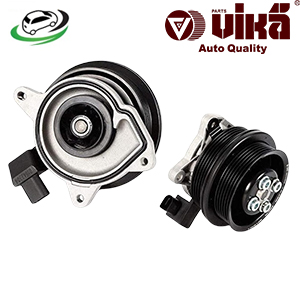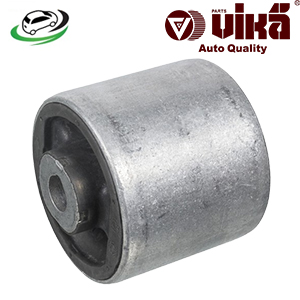-24%
Get Radiator Coolant Hose Adapter (Upper) VW Tiguan 2.0L Engine 2009-2017 5N0122291
The radiator coolant hose adapter is a crucial component within a vehicle’s cooling system, playing a vital role in ensuring proper coolant flow and system integrity. This detailed overview will explore the construction, function, benefits, common issues, and maintenance of radiator coolant hose adapters.
Construction and Function of a Radiator Coolant Hose Adapter
Construction:
The radiator coolant hose adapter is typically made from durable materials such as aluminum, steel, or high-quality plastic. Its design often includes:
- Adapter Body:
- Material: Commonly constructed from metal (aluminum or steel) or reinforced plastic.
- Function: Provides the necessary fittings and connections to join different sections of the coolant hose or connect to other components in the cooling system.
- Fittings:
- Types: Includes various fittings such as barbed, threaded, or quick-connect fittings, depending on the specific application and design of the vehicle’s cooling system.
- Function: Ensures a secure and leak-proof connection between the coolant hoses and the radiator or other cooling system components.
- Seals and O-Rings:
- Material: Made from rubber or silicone to create a tight seal between the adapter and the hoses or radiator connections.
- Function: Prevents coolant leaks and ensures a secure fit.
Function:
- Coolant Flow Management:
- Connection: The adapter connects different sections of the coolant hose or links the hose to other cooling system components, ensuring continuous coolant flow.
- Flow Regulation: Helps direct coolant to various parts of the engine and radiator, maintaining efficient heat transfer and temperature regulation.
- System Integration:
- Component Connection: Facilitates the connection between the radiator, engine block, water pump, and other cooling system components, integrating the system and ensuring proper coolant circulation.
- Coolant Hose Adaptation:
- Hose Compatibility: Adapts various hose sizes and types, enabling the use of different hose configurations or aftermarket hoses that may not fit the original fittings.
Benefits of a Radiator Coolant Hose Adapter
- Enhanced Cooling System Functionality:
- Efficient Flow: Ensures a seamless connection between coolant hoses, contributing to efficient coolant flow and optimal engine cooling.
- Temperature Regulation: Helps maintain proper engine temperatures by ensuring that coolant is directed effectively through the cooling system.
- Improved Flexibility and Compatibility:
- Adaptation: Allows for the use of different hose sizes and types, providing flexibility in hose configurations and enabling compatibility with various cooling system components.
- Aftermarket Options: Facilitates the installation of aftermarket or upgraded hoses and components, enhancing customization and performance.
- Leak Prevention:
- Secure Connections: Provides secure, leak-proof connections between hoses and cooling system components, reducing the risk of coolant leaks.
- Seal Integrity: High-quality seals and O-rings prevent coolant from escaping, maintaining system pressure and performance.
- Durability and Reliability:
- Material Strength: Constructed from durable materials such as metal or reinforced plastic, ensuring long-term reliability and resistance to wear and tear.
- Heat Resistance: Designed to withstand high temperatures and pressures associated with engine cooling systems.
- Ease of Maintenance:
- Simplified Installation: Facilitates easier installation and replacement of coolant hoses and components, streamlining maintenance procedures.
- Part Replacement: Allows for quick replacement or upgrade of hoses and adapters, reducing downtime and maintaining system efficiency.
Common Issues with Radiator Coolant Hose Adapters
- Leakage:
- Seal Failure: Over time, seals and O-rings can deteriorate, leading to coolant leaks around the adapter.
- Loose Fittings: Improperly tightened or worn fittings can also cause leaks, affecting coolant flow and system performance.
- Corrosion and Rust:
- Metal Degradation: Metal adapters can suffer from corrosion or rust, especially if the cooling system is not regularly maintained or if the coolant is contaminated.
- Compromised Integrity: Corrosion can weaken the adapter and lead to leaks or failures.
- Cracking or Breakage:
- Plastic Adapters: Plastic adapters can crack or break under high temperatures or pressure, leading to coolant leaks and system malfunctions.
- Impact Damage: Physical impacts or rough handling can also cause damage to the adapter.
- Compatibility Issues:
- Incorrect Fit: Using an incorrect adapter or hose that does not match the vehicle’s specifications can lead to leaks or poor system performance.
- Improper Installation: Incorrect installation of the adapter or hoses can cause fitment issues and affect the cooling system’s effectiveness.
Signs of a Failing Radiator Coolant Hose Adapter
- Coolant Leaks:
- Puddles Under Vehicle: Finding puddles or spots of coolant under the vehicle may indicate a leak from the adapter.
- Low Coolant Levels: Persistent low coolant levels, despite refilling, can be a sign of a leaking adapter.
- Overheating Engine:
- Temperature Gauge: Frequent overheating or high temperature readings on the dashboard can signal a problem with the coolant flow, potentially related to the adapter.
- Boiling Coolant: Overheating may cause coolant to boil over, leading to steam or smoke from the engine bay.
- Unusual Noises:
- Hissing or Gurgling: Hissing or gurgling noises from the cooling system may indicate a leak or air trapped in the system due to a faulty adapter.
- Poor Cooling Performance:
- Inconsistent Temperature: Inconsistent engine temperatures or inadequate cooling performance can signal issues with the coolant flow or adapter functionality.
- Visible Damage:
- Cracks or Corrosion: Inspect the adapter for visible signs of damage, such as cracks, corrosion, or wear. These issues can affect the adapter’s performance and lead to leaks.
Maintenance and Replacement of Radiator Coolant Hose Adapters
- Regular Inspections:
- Visual Checks: Periodically inspect the radiator coolant hose adapter and associated hoses for signs of leaks, corrosion, or damage.
- Coolant Levels: Monitor coolant levels regularly to ensure that the system is functioning properly and that there are no hidden leaks.
- Seal and Fitting Maintenance:
- Check Seals: Inspect seals and O-rings for wear and replace them if necessary to prevent leaks.
- Tighten Fittings: Ensure that fittings are properly tightened to prevent leaks and maintain a secure connection.
- Timely Replacement:
- Replace Worn Adapters: If signs of failure or damage are detected, replace the radiator coolant hose adapter promptly to avoid potential issues.
- Use Quality Parts: Choose high-quality, OEM, or reputable aftermarket adapters to ensure proper fit and performance.
- System Maintenance:
- Flush Coolant System: Regularly flush the coolant system to prevent contamination and corrosion that can affect the adapter and other components.
- Check for Leaks: After replacing or servicing the adapter, check the entire cooling system for leaks and ensure proper operation.
Follow us on Facebook for more parts.



